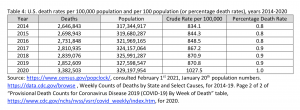Over a year since the outbreak of the pandemic in the U.S., and with data (some of which are still provisional) readily available, one researcher has taken it upon herself to put COVID-19’s death toll in the context of deaths from all causes in recent years.
Genevieve Briand, Ph. D., assistant program director and senior lecturer at Johns Hopkins University, has carried out this exercise in a not-yet-published paper provided to Health Care News. According to Briand, the objective of her paper is “to assess whether the total death number the U.S. experienced during the 2020 calendar year (2019-20 seasonal year) was unexpected or alarming.”
Regarding her methodology, Briand says she “put data downloaded from publicly available CDC [Centers for Disease Control and Prevention] datasets in graphical and tabular form, and (tried) to make sense of them.” Briand emphasized that the data presented in her paper “are not estimates – they are recorded past deaths, maintained and made publicly available by the CDC. The data have not been produced, adjusted, nor tampered with, in any way, by the author.”
Death Rates, Not Numbers
The Morbidity and Mortality Weekly Report by the National Center for Health Statistics (NCHS) reports deaths as a rate, or proportion of a population, instead of a number of deaths. Using rates accounts for changes in population from one year to the next, which, in the case of the U.S., invariably means increases in population.
Briand notes that U.S. death rates have been from 0.8 percent to 0.9 percent of the total population each year from 1999 to 2019. “A difference of 0.1 percent in the death rate of one year over another has been observed and is to be expected,” Briand writes. The U.S. death rate for 2020 was 1.0 percent, up 0.1 percent from 2019. (see Table 4, below, courtesy Briand)

“The death rates show that the total deaths increased in 2020 was not unexpected or alarming, but rather is explained by the population increase,” Briand says. “This result in conjunction with the facts that (1) every recorded death is allocated to one cause, (2) a new cause was specially created for COVID-19, and (3) means to test and record COVID-19 deaths were considerably expanded, points to suspicions that some reclassification between the cause of death and COVID-19 deaths might have occurred.”
In saying that “a new cause was specially created for COVID-19,” Briand is referring to a little-noticed but far-reaching step undertaken by the CDC in the first weeks of the pandemic. On March 24, 2020, the CDC issued guidance to all coroners, medical examiners, and physicians that unilaterally altered the 17-year-old process by which it calculated disease-caused deaths, creating a special classification for tabulating COVID-19 deaths. The CDC’s action was in response to a World Health Organization (WHO) Emergency Use ICD (International Classification of Diseases) Codes for COVID-19 Outbreak. However, as noted in a recent peer-reviewed study by the Institute for Pure and Applied Knowledge, by substantially altering how death is recorded exclusively for COVID-19, “the CDC compromised the quality, objectivity, and integrity of all COVID-19 data collected to date.”
While not prepared to go that far, Briand does raise questions about the CDC’s reclassification of COVID-19 deaths.
“[I]t is not assumed, or even suggested, that such reclassifications if they occurred, were maliciously intended to inflate COVID-19 numbers. Nonetheless, individuals within organizations tend to respond to financial incentives and groupthink to some extent. Similarly, it is not assumed or even suggested that mitigation measures adopted were designed to harm targeted groups in the U.S. population. Nonetheless, the unequal toll those measures have had on individuals across our society cannot be ignored.”
Excess Deaths
On Oct. 20, 2020, the CDC published estimates from the NCHS showing 299,000 excess deaths from late January to October 3, 2020, with two-thirds attributed to COVID-19. A study by L. M. Rossen et al. questioned whether such deaths were underestimated. They then produced estimates of excess deaths using Farrington surveillance algorithms. But Briand points out that “the model they used to produce excess deaths did not account for the increase in population.”
Similarly, a study, “Excess Deaths from COVID-18 and Other Causes in the US, March 1, 2020, to January 2, 2021,” published by jamanetwork.com (April 2) concluded that the nation experienced 22.9 percent more deaths than expected in the period under review.
Unlike the Briand paper, which relies exclusively on publicly available data without adjustments, the study by Steven H. Woolf, MD, MPH, et al. applied a Poisson regression model from 2014-2019 to predict U.S. expected deaths in 2020. Observed deaths in the weeks ending March 1, 2020, to January 2, 2021, were taken from provisional, unweighted death counts for the District of Columbia and 49 states, excluding North Carolina due to insufficient data. “The model does not adjust directly for population aging, which could contribute to an overestimate of excess deaths,” jamanetwork.com notes. “Other study limitations include reliance on provisional data and modeling assumptions.”
By contrast, Briand argues that the data show that the U.S. population did not decrease in the 2020 calendar year. “COVID-19 deaths did not decimate the population,” Briand writes.
Was the response to COVID-19 commensurate with the challenge the disease posed?
“The picture of the U.S. COVID-19 situation was heavily skewed by death numbers from jurisdictions such as New York City and the State of New Jersey,” writes Briand. “At the state level, many have shown no change in death numbers or pattern of deaths in 2019-20 compared to previous seasons.”
Briand then asks, “has any consideration ever been given to the relevance to the national picture and national ‘solutions,’ to state, county, local, and individual situations? Or have COVID-19 measures been blindly adopted and applied, top-down, in haste, obsessively, and shortsightedly? What role did groupthink play in this?”
Lack of Early Treatment
“With all the data manipulation, political posturing, and change of definitions, the only reliable statistic is probably all-cause mortality,” says Jane Orient, M.D., the executive director of the American Association of Surgeons and Physicians. “Despite many painful deaths from COVID-19 – at least 100,000 of which might have been prevented with early treatment, the number and pattern of deaths in most jurisdictions outside of downstate New York were not greatly different from previous years.”
Briand’s work has touched a nerve. A JHU newspaper publication took down an article describing a presentation she made on the topic.
Bonner R. Cohen, Ph.D., (bcohen@nationalcenter.org) is a senior fellow at the National Center for Public Policy Research.
Internet info:
Genevieve Briand, “COVID-19 Deaths – A Look at U.S. Data Feb 2021 Working Paper,” Johns Hopkins University, February 2021: https://www.heartland.org/_template-assets/documents/publications/BRIAND.pdf











[…] By Bonner R Cohen | Heartland […]